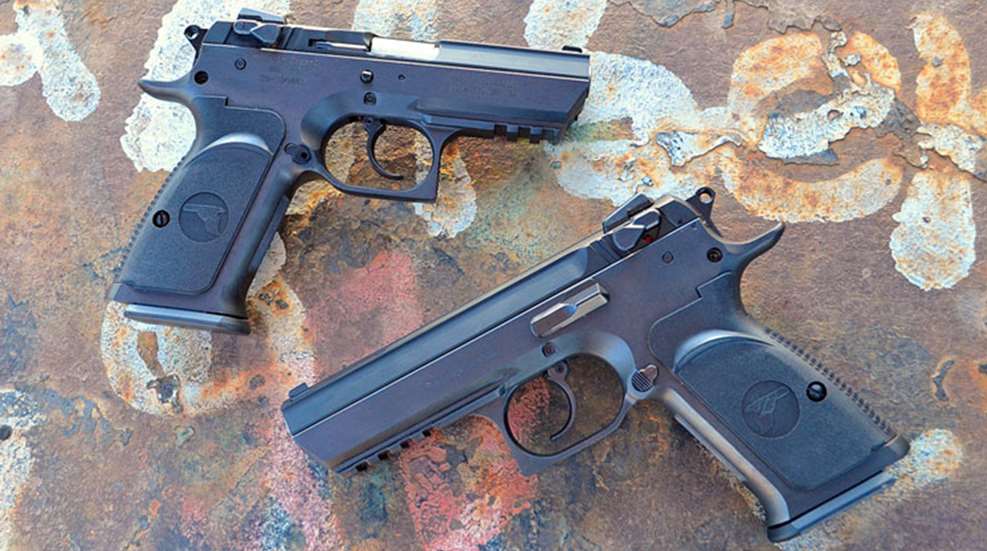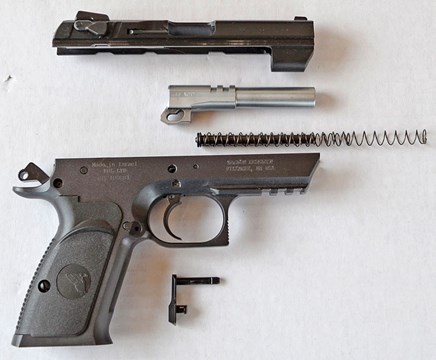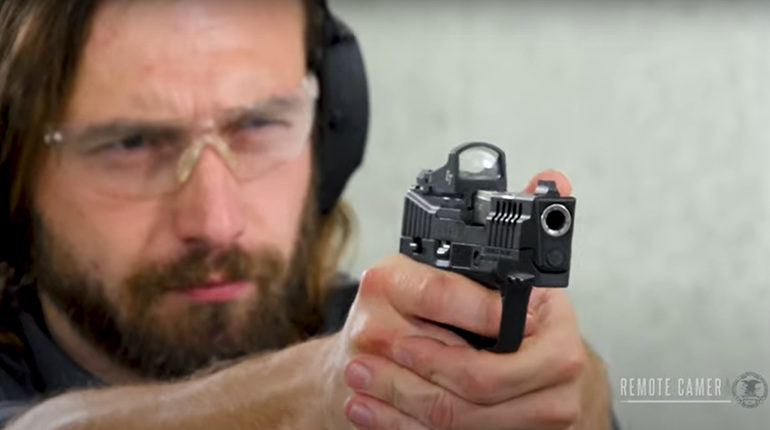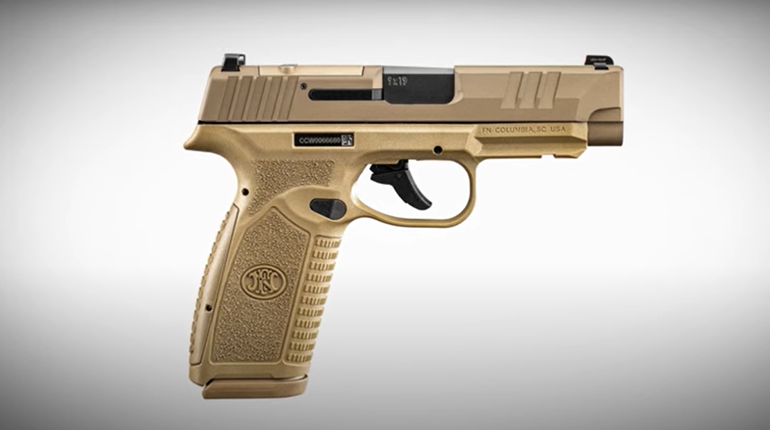
2016 marks the 30-year anniversary for Magnum Research Incorporated (MRI), a company best known for its iconic Desert Eagle pistol. But the Minnesota-based company offers shooters more than just an incredibly powerful semi-automatic handgun. MRI produces a line of rimfire rifles, center-fire bolt guns and single-action revolvers chambered for incredibly potent cartridges like the .45/70. MRI also imports several different styles of semi-automatic pistols including the Baby Desert Eagle III.
Built by the Israeli firm BUL Ltd, the Baby Desert Eagle III pistols were inspired by the CZ-75 pistol with a couple of cosmetic differences and one important mechanical change. When MRI first offered Baby Desert Eagle pistols Israel Weapon Industries (IWI) built the guns. The relationship between MRI and IWI dissolved in December 2014 when their contract expired. IWI decided to set up its own U.S. distribution for its products through IWI US and MRI turned to BUL.
Bul engineers trimmed and slimmed the Baby Desert Eagle and also re-profiled the gun to make it look more like its namesake big brother. The result is the new Baby Desert Eagle III. I received a full-size and semi-compact version of the gun, both chambered in .45 ACP. 
No one will mistake these guns for lightweights. Both the frame and slide are machined from high-quality carbon steel. The full-size gun runs a stout 35 oz. and the semi-compact about an ounce and a half lighter. In terms of size, both guns have the same grip length and use the same 10-round magazine but the semi-compact’s slide, barrel and frame’s dustcover are about .58” shorter.
The ergonomics of the pistol are excellent and the graceful arch of the backstrap lock the shooter’s hand into a comfortable firing grip. There’s an upswept beavertail to protect the web of the hand and the thin synthetic grips prevent the frame from feeling fat. The trigger guard is undercut where it meets the frame, allowing the shooter to get a very high hold on the frame.
Both pistols feature standard Picatinny rail on the frame’s dustcover to allow the attachment of a light/laser. Its trigger guard is squared and grooved at its front for those who like to hook the index finger of their support hand. The magazine release and slide catch are located in the usual, 1911-inspired, location.
Unlike the 1911, the Baby Desert Eagle III pistol’s slide rides inside the frame, giving the slide a sleek profile. The rails run from the rear of the gun to the muzzle and provide the pistol with a tight frame to slide fit and very efficient barrel lock-up, both of which contribute to good accuracy.
An ambidextrous manual safety sits at the rear of the slide. This safety is where the CZ-75 and the Baby Desert Eagle III differ. The CZ-75 possesses a frame-mounted safety, which allows the user the choice of carrying the gun with the hammer down, or with the hammer cocked and the safety engaged, otherwise known as cocked and locked. Engaging the slide-mounted safety on the Baby Desert Eagle III, with the hammer cocked, will lower the hammer. In addition to being a safety it is also a decocker. When engaged it pushes the trigger bar out of engagement. Pushing the safety forward disengages the safety. The gun also incorporates a firing pin safety so the pistol will not fire if dropped on its muzzle with a chamber loaded.
The Baby Desert Eagle III possesses a conventional double-action/single-action trigger system. With the hammer down the first long pull of the trigger will cock the hammer and allow it to go forward—much like a double action revolver. Each subsequent shot will be single action. Double-action trigger pull registers at about 12 lbs. but the single action is very controllable at about 5 lbs. with some take up but relatively crisp. The trigger blade is curved and wide, making the amount of pressure it takes to drop the hammer feel like less.
For the accuracy portion of the evaluation I decided to test the guns at 15 yards. Despite MRI calling the Baby Desert Eagle III a full-size gun, its barrel length is only 4.43”. I wanted to test both guns at the same range for comparison so 15 yards seemed to be appropriate. I shot all of my five-shot groups seated, from a bench with a Millett BenchMaster for support. All groups were fired from single action. The results shown below are the best groups for each gun and ammunition. 
|
|
FULL SIZE |
|
SEMI-COMPACT |
|
|
AMMO |
VELOCITY/ ENERGY |
GROUP |
VELOCITY/ ENERGY |
GROUP |
|
Aguila 230-gr. FMJ |
819 FPS |
1.66” |
793 FPS |
1.85” |
|
Corbon +P 200-gr. JHP |
1078 FPS |
.93” |
1034 FPS |
1.43” |
|
Hornady American |
982 FPS |
1.05” |
956 FPS |
1.27” |
|
Hornady Critical |
1049 FPS |
1.16” |
1014 FPS |
1.31” |
|
Ruger 118-gr. ARX |
1340 FPS |
1.55” |
1307 FPS |
1.17” |
A PACT chronograph was used to record velocities which are listed in feet per second. Energies are listed in foot pounds of energy. All groups were fired from a seated rest with targets at 15 yards. Temperature was 85 degrees with 20 percent humidity.
The pistols displayed an excellent degree of accuracy. During my initial sighting of the pistols I found that the guns were shooting about 3” low at 15 yards so I placed small target pasters above my Shoot N C targets for aiming points. The Baby Desert Eagle III three-dot combat sights were easy to line up and the single-action trigger was crisp enough to enable me to shoot these small groups. Corbon’s +P 200-gr. JHPs produced the best group at just .93” in the full size gun. The semi-compact’s best group was fired with the new Ruger 118- gr. ARX bullets. This is the second caliber I have tested with the new Ruger bullets. In my experience thus far they have provided 100 percent reliability, light recoil, excellent accuracy and shoot to the same point of aim as conventional loads and gives shooters a new and very unique choice for defense ammunition. 

For the field portion of my evaluation I set up some steel targets at 15 yards. Both guns were easy to shoot. The solid heft of the Baby Desert Eagle IIIs made recovery from muzzle rise quick and it was effortless to place very rapid follow-up shots. Felt recoil was negligible and that made concentrating on the sight picture and trigger press simple. 
Disassembly of the Baby Desert Eagle III guns is easy and requires no tools. With the magazine removed and the chamber unloaded place the manual safety in the “fire” position. Push the slide rearward, just a bit, until the witness mark on the frame and slide line up. Now remove the slide catch by pushing its pin from the right side of the frame. Run the slide forward off the frame. The recoil spring and its guide can now be removed and the barrel can be pulled from the slide. Reassemble the gun in the reverse order. The only real difference I found between the full-size gun and the semi-compact, other than the length of the slide and barrel of course, was that the semi-compact uses two recoil springs-one inside the other. 
Neither gun had any malfunctions during the testing. Both consumed all loads without a bobble and even the hot Corbon +P loads proved comfortable to shoot in the steel-framed guns.
The Baby Desert Eagle III pistols are robust guns built for hard use for individuals who eschew polymers and alloys. Because of their size and weight both guns are extremely comfortable to shoot, and possess an uncanny degree of accuracy. The new Baby Desert Eagle III guns are also available with polymer frames and also chambered for 9 mm and 40 S&W. To view the entire line-up check out MRI’s website at magnumresearch.com.
NRA Specifications
|
Manufacturer/Importer |
||
|
Model |
Baby Desert Eagle III Full Size (BE45003R) |
|
|
Operation |
Semi automatic, |
Semi automatic, |
|
Caliber |
.45 ACP |
.45 ACP |
|
Barrel Length |
4.43” |
3.85” |
|
Capacity |
10 + 1 |
10 + 1 |
|
Height |
5.375” |
5.375” |
|
Weight |
35.8 oz. |
34.2 oz. |
|
Overall Length |
8.0” |
7.5” |
|
Slide Width |
1.31” |
1.31” |
|
Construction |
High quality carbon steel frame and slide |
High quality carbon steel frame and slide |
|
Finish |
Black oxide finish |
Black oxide finish |
|
Trigger Action |
Double action/single action |
Double action/single action |
|
Safety |
Slide mounted manual safety/hammer decocker, ambidextrous |
Slide mounted manual safety/hammer decocker, ambidextrous |
|
Sights |
Fixed, drift adjustable for windage, 3-dot |
Fixed, drift adjustable for windage, 3-dot |
|
Grips |
One piece black synthetic |
One piece black synthetic |
|
Magazines |
Two 10-round magazines included |
Two 10-round magazines included |
|
Warranty |
Limited one year |
Limited one year |
|
MSRP |
$691 |
$691 |





































